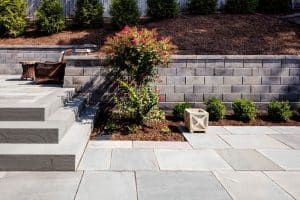
Understanding Paver Materials
When it comes to selecting the ideal paver for your patio, the material plays a crucial role in determining both the appearance and performance of your outdoor space. Each paver type brings its own set of characteristics, advantages, and potential drawbacks. Let’s explore the most popular paver materials to help you make an informed choice for your project.
Concrete Pavers: Versatility Meets Affordability
Concrete pavers have become increasingly popular due to their versatility and cost-effectiveness. These manufactured stones offer a wide range of colors, shapes, and textures, making them suitable for various design styles. Here are some key points to consider:
-
- Durability: Concrete pavers are known for their strength and ability to withstand heavy foot traffic and varying weather conditions.
- Customization: With numerous color and pattern options, concrete pavers can mimic the look of natural stone or brick at a fraction of the cost.
- Maintenance: These pavers are relatively easy to clean and maintain, often requiring only occasional sealing to preserve their appearance.
- Installation: The interlocking design of many concrete pavers allows for straightforward installation, making them a favorite among DIY enthusiasts.
While concrete pavers offer many benefits, it’s important to note that they may fade over time when exposed to prolonged sunlight. However, this can be mitigated with proper sealing and maintenance.
Natural Stone Pavers: Timeless Elegance
For those seeking a more organic and luxurious look, natural stone pavers are an excellent choice. These pavers bring a timeless elegance to any outdoor space and are available in various types, including:
-
- Flagstone: Known for its irregular shapes and earthy tones, flagstone creates a rustic, natural ambiance.
- Bluestone: With its distinctive blue-gray hue, bluestone offers a sophisticated look that complements both traditional and modern home styles.
- Travertine: This light-colored stone is prized for its heat-resistant properties, making it ideal for pool decks and sunny patios.
- Granite: Extremely durable and available in a range of colors, granite pavers provide a high-end finish to any outdoor space.
Natural stone pavers offer unparalleled beauty and durability, but they come with a higher price tag compared to other options. Additionally, some types of natural stone may require more maintenance to prevent staining and weathering.
Brick Pavers: Classic Charm
Brick pavers have been a staple in landscaping for centuries, and for good reason. These timeless elements bring a warm, classic look to any patio design. Consider the following aspects of brick pavers:
-
- Durability: Properly installed brick pavers can last for decades, even in harsh climates.
- Color retention: Unlike some other materials, brick pavers tend to retain their color well over time.
- Slip resistance: The textured surface of brick pavers provides excellent traction, even when wet.
- Eco-friendly option: Many brick pavers are made from recycled materials, appealing to environmentally conscious homeowners.
While brick pavers offer many advantages, they can be more labor-intensive to install due to their smaller size. Additionally, they may develop a patina over time, which some homeowners find charming while others prefer to avoid.
Porcelain Pavers: Modern Sophistication
As a relative newcomer to the outdoor paving scene, porcelain pavers have quickly gained popularity for their sleek appearance and practical benefits. Here’s what you need to know about porcelain pavers:
-
- Low maintenance: Porcelain is non-porous, making it resistant to stains, mold, and mildew.
- Frost-resistant: These pavers can withstand freezing temperatures without cracking or chipping.
- Design versatility: Available in a wide range of colors and patterns, including wood and stone look-alikes.
- Lightweight: Porcelain pavers are easier to transport and install compared to some heavier materials.
While porcelain pavers offer many advantages, they can be more expensive than concrete or brick options. Additionally, professional installation is often recommended due to the precise cutting and laying techniques required.
Paver Styles and Patterns
Once you’ve selected the material for your paver patio, the next step is to consider the style and pattern of your layout. The arrangement of your pavers can dramatically impact the overall look and feel of your outdoor space. Let’s explore some popular paver styles and patterns to inspire your design.
Classic Running Bond
The running bond pattern is a timeless choice that works well with rectangular pavers. In this layout, pavers are arranged in straight lines with each row offset by half a paver length. This creates a simple yet elegant look that complements both traditional and contemporary home styles.
Benefits of the running bond pattern include:
-
- Easy installation, making it suitable for DIY projects
- Versatility in design, as it can be laid in different directions
- Ability to create a sense of movement and flow in your patio space
Sophisticated Herringbone
For a more intricate and eye-catching design, consider the herringbone pattern. This arrangement involves laying rectangular pavers at 45 or 90-degree angles to create a zigzag effect. The herringbone pattern adds visual interest and can make small spaces appear larger.
Key features of the herringbone pattern:
-
- Provides excellent interlocking strength, making it ideal for driveways and high-traffic areas
- Creates a sense of depth and dimension in your patio design
- Works well with both large and small pavers
Circular and Radial Patterns
For a truly unique patio design, circular and radial patterns offer a stunning visual impact. These patterns typically involve custom-cut pavers arranged in concentric circles or fan-like shapes. While more complex to install, the results can be truly breathtaking.
Advantages of circular and radial patterns:
-
- Creates a focal point in your outdoor space
- Adds a sense of movement and flow to your patio design
- Can be combined with other patterns for a more dynamic look
Basketweave Charm
The basketweave pattern creates a woven appearance by alternating the direction of paired rectangular pavers. This classic design adds texture and visual interest to your patio while maintaining a timeless appeal.
Benefits of the basketweave pattern:
-
- Works well with brick and concrete pavers
- Creates an interesting play of light and shadow
- Complements both traditional and contemporary home styles
Designing Your Paver Patio
Creating the perfect paver patio involves more than just selecting materials and patterns. A well-designed patio should seamlessly integrate with your home’s architecture and landscape while meeting your functional needs. Here are some key considerations to keep in mind when planning your paver patio project.
Assessing Your Space
Before diving into the design process, take time to evaluate your outdoor area:
-
- Measure the available space to determine the size and shape of your patio.
- Consider the natural contours of your yard and how they might affect drainage.
- Identify any existing features (trees, shrubs, structures) that need to be incorporated into your design.
- Think about how you plan to use the space – for dining, lounging, or entertaining.
Choosing a Color Palette
The color of your pavers can significantly impact the overall look of your patio. Consider the following when selecting your color palette:
-
- Complement your home’s exterior colors and materials
- Think about the mood you want to create (warm and inviting or cool and serene)
- Consider how the colors will look in different lighting conditions
- Mix and match colors to create borders or patterns within your design
Incorporating Borders and Accents
Adding borders and accents to your paver patio can elevate its design and create visual interest. Some ideas to consider:
-
- Use contrasting colors or materials to create a border around the patio’s edge
- Incorporate inlays or medallions for a custom, high-end look
- Add curved elements to soften the edges of a rectangular patio
- Use smaller pavers to create intricate patterns within larger sections
Planning for Drainage
Proper drainage is crucial for the longevity and functionality of your paver patio. Consider these drainage solutions:
-
- Slope the patio slightly away from your home’s foundation (about 1/4 inch per foot)
- Incorporate permeable pavers or drainage channels in areas prone to water accumulation
- Plan for proper sub-base preparation to ensure water can drain effectively
Installation Considerations
While some homeowners may opt for a DIY approach, installing a paver patio often requires specialized skills and equipment. Here are some key factors to consider when planning your patio installation:
Site Preparation
Proper site preparation is crucial for a long-lasting paver patio. This involves:
-
- Excavating the area to the appropriate depth
- Installing a sturdy sub-base of compacted gravel
- Adding a layer of sand to create a smooth surface for paver installation
- Ensuring proper grading for drainage
Paver Cutting and Fitting
Achieving a polished look often requires precise cutting of pavers to fit around obstacles or create custom designs. This may involve:
-
- Using specialized cutting tools for different paver materials
- Creating smooth curves and edges
- Ensuring tight fits between pavers to prevent shifting
Edging and Jointing
To maintain the integrity of your paver patio, consider:
-
- Installing edge restraints to prevent pavers from shifting
- Choosing an appropriate jointing material (sand or polymeric sand) to fill gaps between pavers
- Properly compacting the finished surface to ensure stability
Professional vs. DIY Installation
While DIY installation can save money, professional installation offers several benefits:
-
- Expertise in proper techniques and best practices
- Access to specialized equipment for efficient installation
- Knowledge of local building codes and permit requirements
- Warranty coverage for workmanship
Maintenance and Care
To keep your paver patio looking its best for years to come, regular maintenance is essential. Here are some tips for caring for your new outdoor space:
Routine Cleaning
Regular cleaning helps prevent stains and the buildup of dirt and debris:
-
- Sweep or blow off loose debris regularly
- Use a mild detergent and water for deeper cleaning
- Consider pressure washing for stubborn stains (with caution to avoid damaging the pavers)
Sealing
Applying a sealer can help protect your pavers from stains and fading:
-
- Choose a sealer appropriate for your paver material
- Reapply sealer every 3-5 years, or as recommended by the manufacturer
- Consider enhancing sealers to bring out the natural colors of your pavers
Weed Prevention
To keep your patio looking pristine, prevent weed growth between pavers:
-
- Use polymeric sand in paver joints to inhibit weed growth
- Apply a pre-emergent herbicide in early spring
- Remove any weeds promptly to prevent spreading
Repairs and Replacements
Address any issues promptly to prevent further damage:
-
- Replace cracked or chipped pavers as needed
- Re-level any areas that have settled or shifted
- Refill joints with sand or polymeric sand as necessary
Enhancing Your Paver Patio
Once your paver patio is installed, consider these enhancements to create a truly inviting outdoor living space:
Outdoor Furniture
Choose furniture that complements your patio design and meets your functional needs:
-
- Consider weather-resistant materials like teak, aluminum, or all-weather wicker
- Create different zones for dining, lounging, and conversation
- Incorporate storage solutions for cushions and outdoor accessories
Lighting
Proper lighting can extend the usability of your patio into the evening hours:
-
- Install low-voltage landscape lighting around the perimeter
- Consider string lights or lanterns for a cozy ambiance
- Incorporate task lighting for outdoor cooking areas
Shade Solutions
Provide protection from the sun to make your patio comfortable throughout the day:
-
- Install a retractable awning or pergola
- Use large umbrellas for flexible shade options
- Plant trees or install vertical gardens for natural shade
Water Features
Add a touch of tranquility to your outdoor space with water features:
-
- Install a small fountain or water wall
- Consider a pondless waterfall for a low-maintenance option
- Incorporate a bubbling rock or urn for a subtle water element
Eco-Friendly Paver Options
For environmentally conscious homeowners, there are several eco-friendly paver options to consider:
Permeable Pavers
These pavers allow water to seep through, reducing runoff and helping to recharge groundwater:
-
- Available in various materials, including concrete and clay
- Ideal for areas prone to flooding or water accumulation
- Can contribute to LEED certification for green building projects
Recycled Materials
Many manufacturers now offer pavers made from recycled materials:
-
- Rubber pavers made from recycled tires
- Glass pavers created from recycled bottles
- Composite pavers incorporating recycled plastics
Locally Sourced Options
Choosing locally sourced pavers can reduce transportation emissions and support local economies:
-
- Look for quarries or manufacturers in your region
- Consider native stone options that complement your local landscape
Paver Patio Costs and Budgeting
Understanding the costs associated with a paver patio project can help you plan and budget effectively. Here’s what you need to know:
Factors Affecting Cost
Several factors can influence the overall cost of your paver patio:
-
- Paver material (concrete, natural stone, brick, etc.)
- Size and complexity of the design
- Site preparation requirements
- Labor costs in your area
- Additional features (borders, inlays, steps, etc.)
Average Cost Ranges
While prices can vary widely, here are some general cost ranges to consider:
-
- Concrete pavers: $10-$20 per square foot installed
- Brick pavers: $15-$25 per square foot installed
- Natural stone pavers: $20-$40 per square foot installed
- Porcelain pavers: $25-$45 per square foot installed
Budgeting Tips
To keep your paver patio project on budget:
-
- Get multiple quotes from reputable contractors
- Consider phasing your project if budget is a concern
- Look for sales or discounts on materials
- Be flexible with your design and material choices
We Design and Install Paver Patios
When designing your paver patio, you have the opportunity to create a stunning outdoor living space that reflects your personal style and complements your home’s architecture. You’ll choose from a wide variety of paver materials, including concrete, natural stone, or brick, each offering unique textures and colors. As you plan your design, you consider factors such as the patio’s shape, size, and pattern layout. You might opt for a classic herringbone pattern, an elegant circular design, or a more contemporary random arrangement. Don’t forget to incorporate borders and accents to add visual interest and define the space.
> Learn More
Creating a beautiful and functional paver patio involves careful consideration of materials, design, installation, and maintenance. By understanding the various options available and planning thoughtfully, you can create an outdoor living space that enhances your home’s value and provides years of enjoyment. Whether you opt for the timeless charm of brick, the versatility of concrete, or the luxury of natural stone, a well-designed paver patio can transform your outdoor area into a stunning retreat for relaxation and entertainment.
Contact us (859-640-0657) for a free consultation!
—

About Presentable Landscaping
Presentable Landscaping provides many landscaping services to our customers in Northern Kentucky and Greater Cincinnati.
